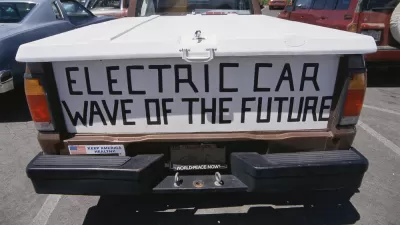The Republican chair of the Senate Transportation Committee is considering an 11.5-cent gas tax increase, setting up a potential conflict with Gov. Jay Inslee's preference to apply a carbon charge to industrial emissions to fund transportation.
"Republican Curtis King, the chair of the Senate Transportation Committee, is looking at an 11.5-cent per gallon increase phased in over three years," writes Austin Jenkins, political reporter for the Northwest News Network. "It would help fund a $14 billion transportation package with projects on both sides of the Cascades." [Listen here.]
It’s been a decade since the last transportation package passed the Washington legislature. Pressure has been building on lawmakers to fund a new round of projects as well as maintenance and preservation of existing roads.
Should King proceed with a gas tax hike, it could set up a conflict with "Democratic Governor Jay Inslee (who) proposed a carbon-emissions charge on industrial emitters," writes Jenkins. A gas tax is the conventional means of funding transportation spending. Even in California, the only state to have a state-run carbon market that requires industries and, effective Jan.1, 2015, transportation fuel wholesalers, to purchase carbon allowances, revenues are not directed to the state Highway User Fund but to the Greenhouse Gas Reduction Fund.
However, as noted here in December, one motivation for the carbon charge was "that the governor has been trying to [raise the gas tax] unsuccessfully for the last two years (see here), so Inslee proposed (Dec. 16) to take a new approach."
Now that a key Republican may propose a comparable gas tax to the carbon charge in terms of revenue, will Inslee drop the cap-and-trade proposal?
Hat tip to AASHTO Daily Transportation Update
FULL STORY: Republican Transportation Leader Eyeing 11.5 Cent Gas Tax Increase

Planetizen Federal Action Tracker
A weekly monitor of how Trump’s orders and actions are impacting planners and planning in America.

Maui's Vacation Rental Debate Turns Ugly
Verbal attacks, misinformation campaigns and fistfights plague a high-stakes debate to convert thousands of vacation rentals into long-term housing.

San Francisco Suspends Traffic Calming Amidst Record Deaths
Citing “a challenging fiscal landscape,” the city will cease the program on the heels of 42 traffic deaths, including 24 pedestrians.

Amtrak Rolls Out New Orleans to Alabama “Mardi Gras” Train
The new service will operate morning and evening departures between Mobile and New Orleans.

The Subversive Car-Free Guide to Trump's Great American Road Trip
Car-free ways to access Chicagoland’s best tourist attractions.

San Antonio and Austin are Fusing Into one Massive Megaregion
The region spanning the two central Texas cities is growing fast, posing challenges for local infrastructure and water supplies.
Urban Design for Planners 1: Software Tools
This six-course series explores essential urban design concepts using open source software and equips planners with the tools they need to participate fully in the urban design process.
Planning for Universal Design
Learn the tools for implementing Universal Design in planning regulations.
Heyer Gruel & Associates PA
JM Goldson LLC
Custer County Colorado
City of Camden Redevelopment Agency
City of Astoria
Transportation Research & Education Center (TREC) at Portland State University
Jefferson Parish Government
Camden Redevelopment Agency
City of Claremont




























